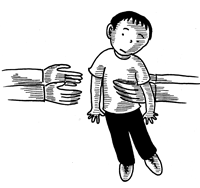![]()
Child care: Another option

Universal day care ignores millions of Canadians who would prefer home care instead, says Tom Wonnacott
The Toronto Star, Oct. 7, 2004, opinion section, by Tom Wonnacott
This week's Speech from the Throne proposed a universal day-care subsidy that shows that our government really cares about our young children. Unfortunately, it is not really universal. It leaves out the millions of Canadian families who, if they could afford it, would like to choose home care — looking after their children at home themselves, or with a loving grandmother or friend.
Many Canadians believe in free choice, whether it is about abortion, or sexual orientation, or raising children. Free choice between day care or home care is a particularly important freedom, however, for several reasons.
First, this choice will provide something that parents have wanted for a long time.
As long ago as 1988, for example, a survey by Statistics Canada showed that of the mothers of young children who were employed part-time, 12 per cent would prefer not to work at all; and of those employed full-time, a whopping 64 per cent would prefer to work less — part-time or not at all.
Second, since most parents generally choose what they feel is best for their children, free choice for parents generally promotes what is best not only for themselves, but for the kids, too. This is in stark contrast to free choice on abortion, which may be good for the mother, but of doubtful benefit to the potential child.
Third, giving parents a choice will make parenthood more attractive, and will help keep our birth rate from falling even further.
It already is way below replacement, with every 100 adults leaving behind only 75 children in the next generation — a 25 per cent drop that is unsustainable).
Now, don't get me wrong. I have nothing at all against day care. I have nothing against home care, either. I just ask that parents have the choice; I'm pro-choice to the core.
Ironically, the feminist revolution was born of the desire to widen women's choice to work in any occupation outside the home. Like many revolutions, in some ways it has got derailed — now it threatens women's choice to work within the home raising their children. Isn't it time to finish the revolution by giving all women complete and equal choice?
This parenting choice could be achieved very simply by giving the parents who choose home care an equal amount of money: no more but no less. That's not only fairest, it also can ensure that parents' choice of home care does not put a higher burden on the taxpayer.
Parents would not actually have to be given the money; they could just be given the appropriate tax relief. The Child Tax Benefit, supported by all parties, would be an excellent way to achieve this, if the government just stopped clawing it back from middle-class families.
To see how important this is, let's look at the net income tax paid last April by two typical middle-class Canadian families.
The first couple, with no kids, earned $40,000 each, for a total household income of $80,000. In the second family, one parent earned the same $80,000, while the other stayed home to look after their three kids.
Since this second family had many more people to support on the same household income — in other words, they had a much lower per capita income — we would expect them to pay considerably less tax. The difference in tax was indeed substantial, $15,000 vs. $18,000. But it is the second, larger family that paid more ..151; an astonishing $3,000 more ../p>
This inequity is not the fault of just the Liberals.
In 1966, the Carter Commission recommended the partial remedy of joint filing, that is, allowing parents to share their income jointly for tax purposes, just as they share in real life.
For example, the second family would be taxed less, as two people earning $40,000 each. Although something like joint filing is commonly done in other countries, it has not yet been done in Canada.
Paradoxically, the government will be heavily taxing families who choose home care, to pay for couples who use day care. This financial pressure, realistically estimated at more than $15,000 per year for a family with two young children, will force many parents to take day care, no matter how much they might prefer home care.
One way or another, the government should give the same amount of money to a family, regardless of their choice. Then they could freely choose to spend this money on day care, or else use it to supplement their income so they could afford to work less — perhaps half-time — and so give their children home care.
This would correct an injustice, it is fair, it gives free choice, and its side effects are generally good.
Prime Minister Paul Martin, what are you waiting for?
Tom Wonnacott teaches statistics and demography at the University of Western Ontario.




